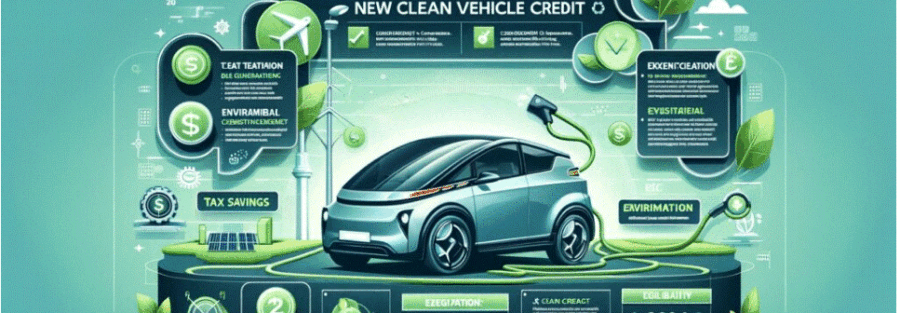Clean Car Energy Qualifications We’ll help you determine whether your purchase of an electric vehicle (EV) or fuel cell vehicle (FCV) qualifies for a tax credit based on whether you are:
- Planning to buy a new clean vehicle
- Looking to claim a credit for a new clean vehicle you already bought
- Planning to buy or already bought a used clean vehicle
- Buying a vehicle for business use
This page covers rules before and after changes under the Inflation Reduction Act of 2022.
At the time of sale, a seller must give you information about your vehicle’s qualifications. Sellers must also register online and report the same information to the IRS. If they don’t, your vehicle won’t be eligible for the credit.
Planning to buy a new vehicle for personal use
Credits under these rules are available through 2032.
- How the credit works and qualified vehicles
- Check to see if the vehicle you are interested in qualifies
Step 1: Check eligibility
Make sure you meet the necessary criteria as a buyer and the make and model you plan to buy is eligible for a credit.
Vehicles purchased for commercial use follow a different process and don’t require the seller to provide a time-of-sale report.
Step 2: Purchase vehicle
When you buy the vehicle:
- Confirm with the seller the car you have selected is eligible for the credit.
- Choose when to take the credit:
- Take the credit immediately: Reduce the amount you pay at the time of sale for the vehicle by transferring the credit to the seller. The dealer must be a registered dealer and vehicle must be purchased mainly for personal use. You can make no more than 2 elections to transfer a clean vehicle credit each tax year.
- Wait and take the credit when you file your tax return for the year when you took possession of the vehicle. Possession is when the car is delivered to you or you drive it off the lot.
For more information on how to transfer a credit see the Frequently asked questions about transfer of New Clean Vehicle Credit and Previously Owned Clean Vehicles Credit.
Step 3: Get a time-of-sale report
When you take possession of the vehicle, the seller must give you a time-of-sale report and a copy of the confirmation the IRS provides when it accepts the time-of-sale report. This gives you:
- Proof of your purchase’s eligibility for the credit, the amount of the credit available for the specific VIN you are purchasing, and whether the credit was transferred to the dealer.
- Confirmation that the dealer reported the sale to the IRS within the required 3-day period.
If you have a paper copy of your time-of-sale report, skip to Step 5.
If you didn’t receive a time-of-sale report, proceed to Step 4.
Step 4: If you didn’t get a time-of-sale report: Contact your seller
If you didn’t get a time-of-sale report at the time of purchase or you lost it, contact the seller to get a copy of the report.
If you can’t get a copy from the seller and more than 3 days have passed since the purchase date, proceed to Step 5.
Step 5: File Form 8936 with your tax return
You don’t need a printed copy of the time-of-sale report to qualify for the credit.
However, you will need to file Form 8936, Clean Vehicle Credits when you file your tax return for the year in which you took delivery of the vehicle. You must file the form whether you transferred the credit at the time of sale or you’re claiming the credit on your return.
If the return is rejected due to Form 8936, ensure the VIN was input correctly. Note there are no letters “O”, “Q” or “I” in a VIN. If the VIN was input correctly and you believe the vehicle is eligible, attach a file or explanation to substantiate the purchase before resubmitting the return.
Who qualifies
You may qualify for a credit up to $7,500 under Internal Revenue Code Section 30D if you buy a new, qualified plug-in EV or fuel cell electric vehicle (FCV). The Inflation Reduction Act of 2022 changed the rules for this credit for vehicles purchased from 2023 to 2032.
The credit is available to individuals and their businesses.
To qualify, you must:
- Buy it for your own use, not for resale
- Use it primarily in the U.S.
In addition, your modified adjusted gross income (AGI) may not exceed:
- $300,000 for married couples filing jointly or a surviving spouse
- $225,000 for heads of households
- $150,000 for all other filers
You can use your modified AGI from the year you take delivery of the vehicle or the year before, whichever is less. If your modified AGI is below the threshold in 1 of the 2 years, you can claim the credit.
If you do not transfer the credit, it is nonrefundable when you file your taxes, so you can’t get back more on the credit than you owe in taxes. You can’t apply any excess credit to future tax years.
Credit amount
The amount of the credit depends on when you placed the vehicle in-service (took delivery), regardless of purchase date.
For vehicles placed in-service January 1 to April 17, 2023:
- $2,500 base amount
- Plus $417 for a vehicle with at least 7 kilowatt hours of battery capacity
- Plus $417 for each kilowatt hour of battery capacity beyond 5 kilowatt hours
- Up to $7,500 total
In general, the minimum credit will be $3,751 ($2,500 + 3 times $417), the credit amount for a vehicle with the minimum 7 kilowatt hours of battery capacity.
For vehicles placed in-service April 18, 2023 and after:
Vehicles will have to meet all of the same criteria listed above, plus meet new critical mineral and battery component requirements for a credit up to:
- $3,750 if the vehicle meets the critical minerals requirement only
- $3,750 if the vehicle meets the battery components requirement only
- $7,500 if the vehicle meets both
A vehicle that doesn’t meet either requirement will not be eligible for a credit.
Qualified vehicles
Click the button below to see if a vehicle is eligible for the new clean vehicle credit.
Go to fueleconomy.gov
To qualify, a vehicle must:
- Have a battery capacity of at least 7 kilowatt hours
- Have a gross vehicle weight rating of less than 14,000 pounds
- Be made by a qualified manufacturer
- Undergo final assembly in North America
- Meet critical mineral and battery component requirements (as of April 18, 2023)
The sale qualifies only if:
- You buy the vehicle new.
- The seller reports required information to you at the time of sale and to the IRS.
- Sellers are required to report your name and taxpayer identification number to the IRS for you to be eligible to claim the credit.
In addition, the vehicle’s manufacturer suggested retail price (MSRP) can’t exceed:
- $80,000 for vans, sport utility vehicles and pickup trucks
- $55,000 for other vehicles
MSRP is the retail price of the automobile suggested by the manufacturer, including manufacturer installed options, accessories and trim but excluding destination fees. It isn’t necessarily the price you pay.
You can find your vehicle’s weight, battery capacity, final assembly location (listed as “final assembly point”) and VIN on the vehicle’s window sticker.
How to claim the credit
To claim the credit, file Form 8936, Clean Vehicle Credits with your tax return. You will need to provide your vehicle’s VIN.
Get a time-of-sale report
The dealer should give you a paper copy of a time-of-sale report when you complete your purchase.
- Keep this copy for your records because it affirms that the dealer sent a report to the IRS on the purchase date.
- If you didn’t receive a copy of the report, follow our step-by-step guide.
File Form 8936 with your tax return
You must file Form 8936 when you file your tax return for the year in which you take delivery of the vehicle. This is true whether you transferred the credit at the time of sale or you’re waiting to claim the credit when you file.
If you have questions or concerns, follow our step-by-step guide.



